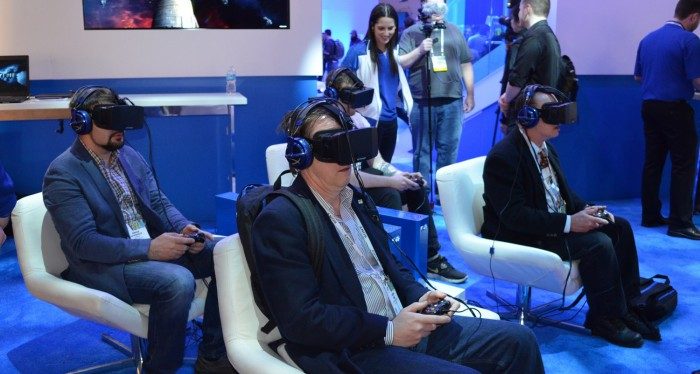In a surprising appearance, the team behind Eve Valkyrie showed up at Intel’s CES 2014 booth with four Oculus Rift HD prototypes connected in a networked environment running multiplayer matches of the forthcoming virtual reality space dog-fighter.
Early yesterday morning I took to Intel’s pre-show booth reveal, expecting the usual array of Ultrabooks and Atom-based tablets. After mulling around and checking out the latest and greatest in Intel silicon, I uncovered a small corner of their large booth with some familiar faces. Drowned in the light of Intel’s signature blue color was Ian Shiels, UX Designer at CCP Games, and Adam Kahn, Director of Corporate Communications at CCP. Both were hovering around a four seat setup consisting of gaming desktops and Oculus Rift prototypes. Running on the systems was Eve Valkyrie, CCP’s forthcoming virtual reality space dog-fighter.
Actually, I suppose we can now call it an ‘Oculus Rift space dog-fighter’—for the first time CCP is confirming that Eve Valkyrie will launch with Oculus Rift support. That’s not really a surprise to anyone, but since announcing Eve Valkyie (formerly EveVR) the company would only say that the game was being made for “virtual reality.” Now it sounds like they’ve got things straightened out with Oculus and are comfortable saying that Eve Valkyrie will launch with full Oculus Rift support.
Beyond that confirmation, there was something else exciting. Something easy to overlook. That being: Intel had invited CCP to their booth for the Oculus Rift factor. If Intel had a passing interest in the Oculus Rift, using it merely to attract folks to their booth, I’m sure they wouldn’t have gone through the trouble of getting in touch with CCP to have them bring a full quad Eve Valkyrie setup, with HD protoypes, all the way from the UK. Not to mention that CCP wasn’t showing anywhere but Intel’s booth.
With Valve on the midst of bringing Oculus-ready Steam Boxes to the living room—many powered by Intel hardware—interest from Intel is nothing but good.
As the company providing the tech behind a huge number of consumer computing devices, Intel is always looking for future trends and adapting their computing platforms to best serve that functionality.
Having a hardware company like Intel interested in VR and the Oculus Rift is a huge boon because it opens the door to potential changes to the base hardware that could reduce latency and further enhance the VR experience. In the same way that Intel has built dedicated encoders and decoders into their CPUs to support high quality video playback on low-end hardware, Intel could build in special features to help enable VR. Perhaps, for instance, something to help handle the object-space correction technique for HMD distortion that Intel pioneered at its Visual Computing Institute.








